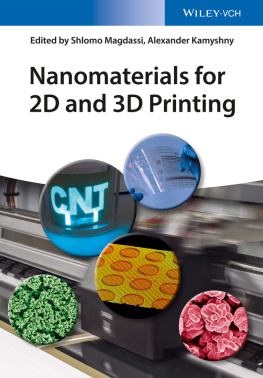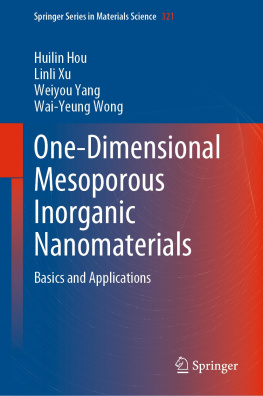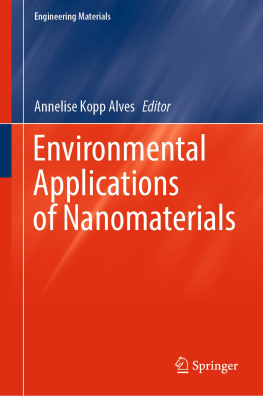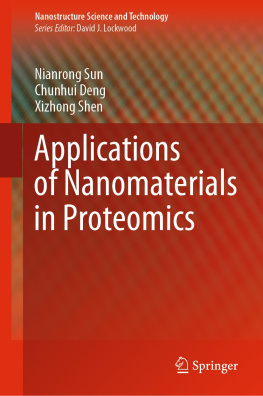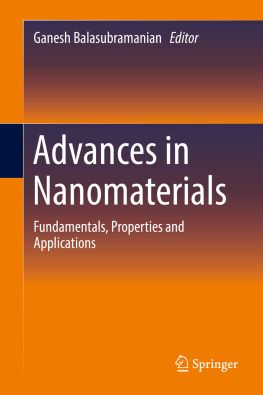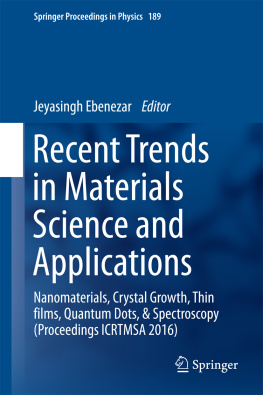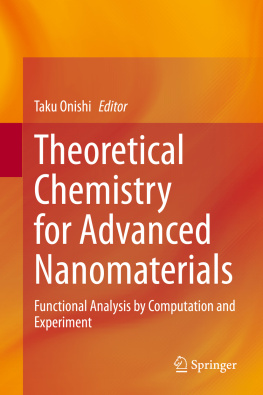
Editors
Prof. Shlomo Magdassi
The Hebrew University of Jerusalem
Casali Center for Applied Chemistry
Edmond J. Safra Campus
91904 Jerusalem
Israel
Dr. Alexander Kamyshny
The Hebrew University of Jerusalem
Casali Center for Applied Chemistry
Edmond J. Safra Campus
91904 Jerusalem
Israel
Cover: Background: fotolia/TASPP Pictures in the circles are kindly provided by the editors.
All books published by Wiley-VCH are carefully produced. Nevertheless, authors, editors, and publisher do not warrant the information contained in these books, including this book, to be free of errors. Readers are advised to keep in mind that statements, data, illustrations, procedural details or other items may inadvertently be inaccurate.
Library of Congress Card No.: applied for
British Library Cataloguing-in-Publication Data
A catalogue record for this book is available from the British Library.
Bibliographic information published by the Deutsche Nationalbibliothek
The Deutsche Nationalbibliothek lists this publication in the Deutsche Nationalbibliografie; detailed bibliographic data are available on the Internet at .
2017 Wiley-VCH Verlag GmbH & Co. KGaA, Boschstr. 12, 69469 Weinheim, Germany
All rights reserved (including those of translation into other languages). No part of this book may be reproduced in any form by photoprinting, microfilm, or any other means nor transmitted or translated into a machine language without written permission from the publishers. Registered names, trademarks, etc. used in this book, even when not specifically marked as such, are not to be considered unprotected by law.
Print ISBN: 978-3-527-33819-1
ePDF ISBN: 978-3-527-68582-0
ePub ISBN: 978-3-527-68580-6
Mobi ISBN: 978-3-527-68584-4
oBook ISBN: 978-3-527-68579-0
Cover Design Grafik-Design Schulz
List of Contributors
- Robert Abbel
- TNO, Equipment for Additive Manufacturing (EfAM)
- De Rondom 1
- 5612 AP Eindhoven
- The Netherlands
- Mutalifu Abulikamu
- School of Electrical Engineering and Computer Science
- University of Ottawa, and Centre for Research in Photonics
- Advanced Research Complex
- Ottawa, ON
- Canada
- Teppei Araki
- Osaka University
- The Institute of Scientific and Industrial Research
- 81 Mihogaoka
- Ibaraki, Osaka 5670047
- Japan
- Niamh T. Brannelly
- University of the West of England
- Bristol BS16 1QY
- UK
- Guofa Cai
- Nanyang Technological University
- School of Materials Science and Engineering
- 50 Nanyang Avenue
- Singapore 639798
- Singapore
- Hyung W. Choi
- University of Cambridge
- Engineering Department
- Trumpington Street
- Cambridge CB2 1PZ
- United Kingdom
- Jin-Woo Choi
- Louisiana State University
- School of Electrical Engineering and Computer Science
- 3101 Patrick F. Taylor Hall
- Baton Rouge, LA 70803
- USA
- Peter Darmawan
- Nanyang Technological University
- School of Materials Science and Engineering
- 50 Nanyang Avenue
- Singapore 639798
- Singapore
- Alice L.-S. Eh
- Nanyang Technological University
- School of Materials Science and Engineering
- 50 Nanyang Avenue
- Singapore 639798
- Singapore
- Adam Ellis
- The University of Sheffield
- Department of Mechanical Engineering
- Mappin Street
- Sheffield
- South Yorkshire S1 3JD
- UK
- Maria Farsari
- IESL-FORTH
- N. Plastira 100
- 70013 Heraklion
- Crete
- Greece
- Elliot J. Fleet
- NetComposites Ltd.
- Chesterfield
- Derbyshire
- UK
- Stav Friedberg
- Tel-Aviv University
- Department of Physical Electronics
- 69978 Ramat-Aviv
- Tel-Aviv
- Israel
- Hanna Haverinen
- School of Electrical Engineering and Computer Science
- University of Ottawa, and Centre for Research in Photonics
- Advanced Research Complex
- Ottawa, ON
- Canada
- Ghassan Jabbour
- School of Electrical Engineering and Computer Science
- University of Ottawa, and Centre for Research in Photonics
- Advanced Research Complex
- Ottawa, ON
- Canada
- Sunho Jeong
- Division of Advanced Materials
- Korea Research Institute of Chemical Technology (KRICT)
- 141 Kajeong-ro, Yuseong-gu
- Daejeon 305-600
- Republic of Korea
- Jinting Jiu
- Osaka University
- The Institute of Scientific and Industrial Research
- 81 Mihogaoka
- Ibaraki
- Osaka 5670047
- Japan
- Alexander Kamyshny
- The Hebrew University of Jerusalem
- Casali Center of Applied Chemistry, Institute of Chemistry
- Edmond J. Safra Campus
- 91904 Jerusalem
- Israel
- Anthony J. Killard
- University of the West of England
- Bristol BS16 1QY
- UK
- Minxuan Kuang
- Key Laboratory of Green Printing, Chinese Academy of Sciences, and Engineering Research Center of Nanomaterials for Green Printing Technology
- Institute of Chemistry
- Zhongguancun North First Street 2
- Beijing 100190
- China
- Pooi S. Lee
- Nanyang Technological University
- School of Materials Science and Engineering
- 50 Nanyang Avenue
- Singapore 639798
- Singapore
- Max C. Lemme
- KTH Royal Institute of Technology
- School of Information and Communication Technology
- Electrum 229
- 16440 Kista
- Sweden
- and
- University of Siegen
- Department of Electrical Engineering and Computer Science
- Hlderlinstr. 3
- 57076 Siegen
- Germany
- Jiantong Li
- KTH Royal Institute of Technology
- School of Information and Communication Technology
- Electrum 229
- 16440 Kista
- Sweden
- Jing Liu
- Chinese Academy of Sciences
- Technical Institute of Physics and Chemistry
- 29 Zhongguancun East Road
- Haidian District
- Beijing, 100190
- China
- Shlomo Magdassi
- The Hebrew University of Jerusalem
- Casali Center of Applied Chemistry Institute of Chemistry and The Center for Nanoscience and Nanotechnology
- Edmond J. Safra Campus
- 91904 Jerusalem
- Israel
- Rajesh Mandamparambil
- Technische Universiteit Eindhoven
- TNO Industrie
- De Rondom 1
- 5612 AP Eindhoven
- The Netherlands
- Erwin R. Meinders
- TNO
- Equipment for Additive Manufacturing (EfAM)
- De Rondom 1
- 5612 AP Eindhoven
- The Netherlands
- Jooho Moon
- Yonsei University
- Department of Materials Science and Engineering
- 50 Yonsei-ro, Seodaemun-gu
- Seoul 120-749
- Republic of Korea
- Mikael stling
- KTH Royal Institute of Technology
Next page
